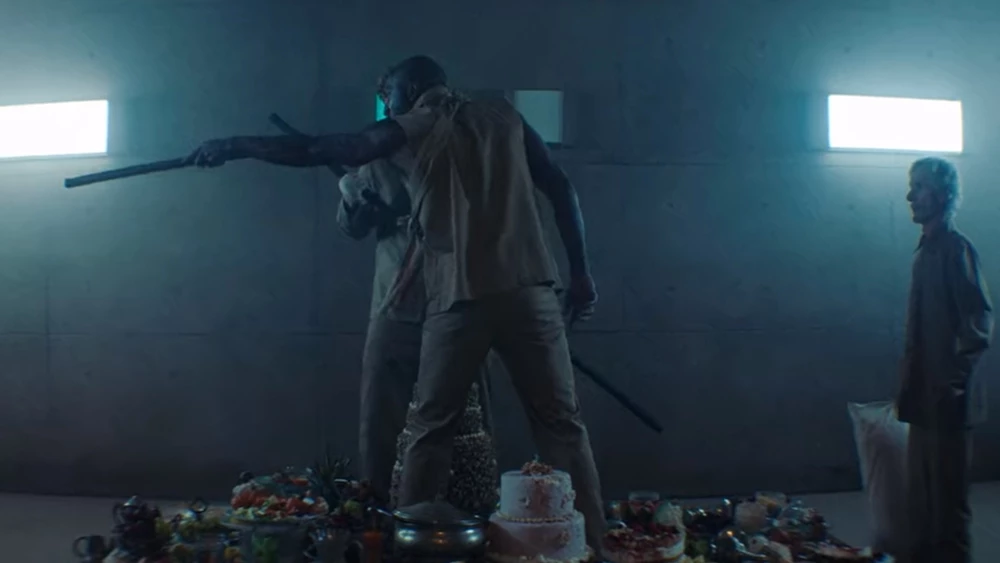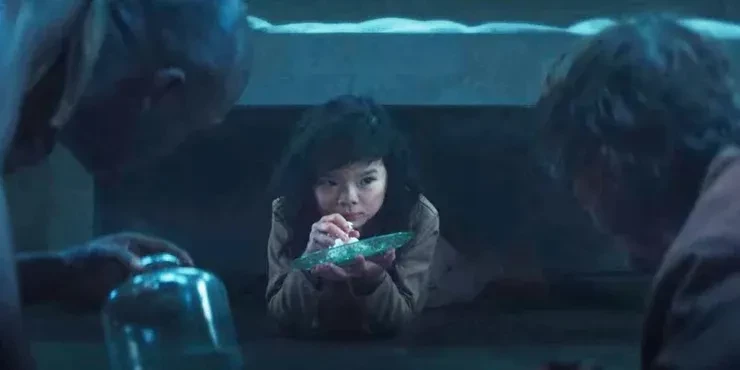'The Platform' Ending Explained: Is Goreng Dead And What Does It All Mean?
Netflix's "The Platform," directed by Galder Gaztelu-Urrutia, has left audiences pondering its intricate and metaphor-laden conclusion. This dystopian thriller, with its blend of horror and social commentary, weaves a narrative that extends beyond individual survival, delving into themes of societal structure, economic disparity, and the consequences of ideological experiments.
Advertisement
What Happens At The End Of 'The Platform'?

Set in a vertical prison known as the Vertical Self-Management Center (VSC), the film follows Goreng, an idealistic intellectual played by Iván Massagué, as he navigates the harsh realities of this starkly divided environment. In this nightmarish setting, a platform laden with food descends through the levels, presenting a moral challenge to its inhabitants.
The Climax
In the climactic conclusion of Netflix's "The Platform," the protagonist, Goreng, reaches the lowest level of the vertically structured prison known as the Vertical Self-Management Center (VSC). Armed with weapons, he and his cellmate Baharat enforce rationing by beating and, in some cases, killing those who attempt to take more than their share of the descending food platform. Goreng's initial plan is to return to the top level with an uneaten dessert, aiming to demonstrate that prisoners can cooperate to survive within the system.
However, the plot takes a dramatic turn when Goreng and Baharat discover Miharu's mute child at the very bottom of the pit, on Level 333. This revelation challenges his original intention, and he realizes that sending the child back up with a message is more impactful than proving their ability to work within the system. They decide to let the child eat the dessert, altering their initial plan.
Is Goreng Dead?
Goreng and Baharat are fatally wounded, and the success or failure of their message is uncertain, allowing viewers to form their conclusions about the system's sustainability and the potential for change.
'The Platform' Ending Explained

"The Platform" is a dystopian allegory that explores social hierarchies, consumerism, and altruism within the confines of a vertical prison. As the film unfolds, it becomes clear that the Vertical Self-Management Center is an experiment designed to cultivate a "spontaneous sense of solidarity" among prisoners. Imoguiri, a former administrator turned inmate, reveals the administration's intention to create a system where people naturally share resources without communication.
Goreng's interpretation, however, leans towards a more sinister view. He suggests that the experiment is a tool for the ruling class to understand and control the proletariat within a harsh capitalist system. The struggle for survival in the pit is a microcosm of societal dynamics.
The conclusion sees Goreng challenging the administration's deception by sending Miharu's child, an unexpected presence in the pit, back up with a message. The child symbolizes the innocent victims of the system, and Goreng aims to expose the cruelty of those in power. The film's director, Galder Gaztelu-Urrutia, emphasizes that the ending is open to interpretation.
Director's Explanation
Galder Gaztelu-Urrutia, the film's director, emphasizes that "The Platform" critiques various ideologies. While it initially appears to critique capitalism, Goreng's attempt at socialism leads to unintended consequences, highlighting the challenges of demanding universal collaboration.
"We certainly do think that there has to be a better distribution of wealth, but the film is not strictly about capitalism," said Gaztelu-Urrutia. "There may be a criticism of capitalism from the beginning, but we do show that as soon as Goreng and Baharat try out socialism to convince the other prisoners to willingly share their food, they end up killing half of the people they set out to help."
"In the end, the problem arises when you try to demand everyone's collaboration, and you see that there is no big achievement by the end. Goreng does what he set out to do in bringing the panna cotta and the child down to the lowest level, but he didn't change anyone's mind about sharing the food [...] To me, that lowest level doesn't exist. Goreng is dead before he arrives, and that's just his interpretation of what he felt he had to do," the director continued.
Gaztelu-Urrutia aimed for The Platform's conclusion to be "open to interpretation, whether the plan worked and the higher-ups even care about the people in the pit." An alternate ending of was even filmed, though it was obviously scrapped in favor of the one viewers saw. "We actually did film a different ending of the girl arriving at the first level, but we took it out of the movie," said Gaztelu-Urrutia. "I'll leave what happens to your imagination."Gaztelu-Urrutia intentionally leaves the ending open to interpretation, with an alternate ending filmed but excluded, allowing viewers to contemplate the fate of the characters.
Alternate Ending
An alternate ending was filmed but omitted, leaving the ultimate fate and impact of Goreng's mission to the viewer's imagination. "We actually did film a different ending of the girl arriving at the first level, but we took it out of the movie, I'll leave what happens to your imagination," said Gaztelu-Urrutia.
Conclusion
"The Platform" transcends its surface narrative, offering a thought-provoking exploration of societal structures and human behavior. The ending, rich with symbolism and ambiguity, encourages viewers to reflect on the implications of systemic injustice and the challenges of instigating meaningful change. As the platform ascends and descends, so does the film's impact, leaving audiences with a haunting and open canvas for contemplation.
Related Articles
- 24 Stunning Images So Far From Netflix’s Avatar: The Last Airbender
- Is Netflix's "Holiday In the Vineyards" A Christmas Gem Or A Forgettable Flop?
- The Midnight Club Ending Explained: What The Twist Entails
- 'Us' Ending Explained: What The 'Tethered' Twist Means
- Netflix's Top 10 Must-Watch Movies Of 2023, Ranked
- 'Saving Bikini Bottom: The Sandy Cheeks Movie' Release Date Confirmed By Netflix
- Stranger Things Season 5 Release Date: Production Set to Begin After Strikes Delay
- 'Rising Impact' Netflix Release Date And Teaser Trailer Revealed
- The Crown Season 6 Part 2 Release Date: Royal Drama's Finale
- Netflix's "The Brothers Sun": Release Date And All Essential Info
Share this article
Advertisement